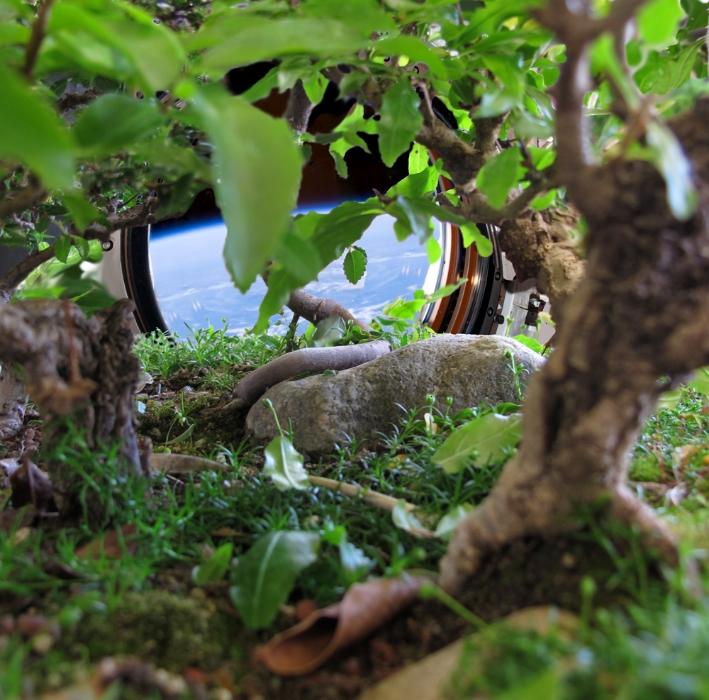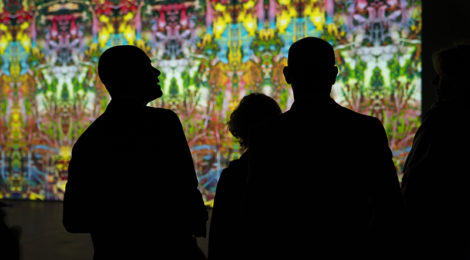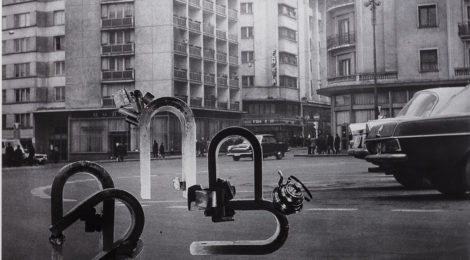Milan, October 2024 – Body as Laboratory: Topics in Space Medicine from the Artist Perspective. In this paper I cover several topics in space medicine and propose cybernetic exercises for astronauts, modifications to weightless training, and new sleeping architectures for the rebuilt ISS that is due to come online in the next decade. Using research with test subjects in flotation tanks, a literature review on health and performance in space (including those involving animals), the paper discusses pre-flight mental training that could borrow from Traditional Chinese Medicine (TCM) as well as take cues from performance art, contact improvisation, dance choreography, and expanded fields of sculpture. The paper’s conclusion lands on the way that art languages of the body are not only relevant to human factors in astronautics but are insightful access points to discover many ways that bodily movement, cognition, and health are informed by the imagination.
“Cognitive Estrangement”
Out now: Science Fiction (Documents in Contemporary Art) (Whitechapel Gallery/MIT Press, 2020). I have a contribution to the “Cognitive Estrangement” section, which reprints my review of the exhibition “How to Build a Universe” at the CCA Wattis Institute (Flash Art, March/April 2007). In addition to analyzing several works’ relationship to urban collapse and renewal, I focus on the ways in which Philip K. Dick is evoked by the curator, but Dick’s humorous apocalyptic Christianity is – to the detriment of the otherwise excellent show – unfortunately suppressed.
In a November 3, 2020 installment of The Nomadic Journal I wrote a piece, Pandemic BLM Politics that looks at graffiti, posters, and street art from the most viral year on record this century. Photo contributions from Long Beach by artist Mario Ybarra, Jr. and from New York by art critic Seph Rodney.
Search for much more of my art writing
on Artillery.
Interstellar Messaging: An Embodied Perspective - chapter in a book of conference proceedings from Heavenly Discourses, University of Bristol. (Sophia Centre Press, 2016)
2015 articles:
"Turning Art Upside Down: An Interview with Mexican Space Artist Nahum" (Artillery, March 16, 2015)
Studio Visit with Maryrose Cobarrubias Mendoza (The Nomadic Journal, February 14, 2015)
Space Art Is in the Eye of the Beholder (Astronomers without Borders Astro-Arts Blog, March 5, 2015)
“Greenhouses and Their Humanizing Synergies,” coauthored with Sandra Haeuplik-Meusburger, Daniel Schubert and Paul Zabel (peer-reviewed journal of astronautics: Acta Astronautica, March/April 2014) available here.
left: Expedition 5 cosmonaut Victor Savinykh with plants on Salyut 6 (image credit: Spacefacts, J. Becker).
“Developing Green Solutions for Astronaut Headspace,” paper presented at the 65th International Astronautical Congress, Toronto, October 3, 2014
right: Bruce Dern in Silent Running, dir. Douglas Trumbull, 1972
The Edge in CalArts' Theater Festival (Artillery, Oct 3, 2013)
Christina Fernandez, Lavanderia #1, 2002; Julio Cesar Morales, Undocumented Interventions #5 (detail-one of ten), 2005
Nothing Is More or Less Alive: A Conversation with Eduardo Kac (Sculpture, April 2011)
Architectural Inventions
Edited by Matt Bua and Max Goldfarb (Laurence King Publishing, 2013). Included are working and mechanical drawings for my collapsing elevator, PEGLEG: Up for War, a memorial to Space Shuttle Columbia (2004-2008).
Paul Thek
UCLA Hammer Museum - published in Artillery, September/October 2011
"DIVER" PROFFERS SCANT remnants of Paul Thek's massive, often-collaborative and ephemeral installations. The retrospective conjoins these remains with rarely seen paintings, small objects and notebooks to create a very different picture of Thek than the vaunted, mythological "artist's artist" legendary to many. With pleasure we read Thek by Thek, finally.
Paul Thek, Untitled (Diver), 1969-1970
A revelatory way to see the exhibition is to walk through it backward chronologically — "against interpretation" — as may have been advised by Thek's friend Susan Sontag, who dedicated her seminal book of essays with the same title to him in 1966.
Starting in the extant gallery — almost an afterthought to the main exhibition space — viewers encounter humble paintings from Thek's last show hung low on the wall. While he lay dying of complications from AIDS in the summer of 1988, none of the works sold. Time is a River and Dust (both 1988) — only two examples of many in the room — carry a bright turquoise hue as resonant theme. Across the color appears Thek's poetry imbued with a reflected light like sun glinting off the water. While there is time (1987), Thek painted the year before, "let's go out and / and feel everything."
Paul Thek loved the sensuality of the world but had monastic longings. A Roman Catholic, he was devoutly interested in materiality at its vanishing point — death. His journals are filled with a crux of observations and poetical indulgences at the point where spirit meets body meets humanity, the eye of the world. A show of Thek's multitudinous private notebooks alone could have carried the day.
Paul Thek, Untitled (Earth Drawing I) ca. 1974. Estate of George Paul Thek Courtesy Alexander and Bonin, New York.
Other simple objects with this power include Untitled (globe) (1973), a glass orb painted like Earth sitting in a nest, and Portable Ocean (1969), a construction of a child's wooden wagon with blocks painted in atmospheres. As Thek and Sontag may have concurred, materiality is just a state of potential that art and hermeneutics release.
Thek's icy clouds protect softer viscera. Only seen upon crossing the next threshold on this backward trajectory are the installation and meat works visible — this is the raw Thek who is everyone's favorite, the one with balls. Refreshingly we learn that Thek was not just that artist. In fact he "suicided" his most famous work The Tomb (1967), which featured a naked, full-body replica of himself in a pink ziggurat — dead — by refusing its shipment back to him in New York in the early '80s. Weighing in on the side of life, not art, he is said to have rebelled when asked to show it: "Not that piece again! Imagine having to bury yourself over and over."
Paul Thek - "Diver" - UCLA Hammer Museum
In the next room, Thek's mid-'60s series Technological Reliquaries are a perversion of Smithson, Judd and Minimalism in general, encasing theatrics and horror. Thek's prosthetic incursions into pure geometric space demonstrate that the voice of the artist emerged from deep within the body. "We accept our thingness intellectually but the emotional acceptance of it can be a joy," wrote a young Thek upon his visit to the Capuchin catacombs with his lover Peter Hujar, photographer for much of Thek's studio ephemera on display.
Stepping out of the meat room at last into the entry vestibule, a huge projection of Warhol's Screen Test: Paul Thek [St337] (1964) shows a clean-shaven Thek blinking calmly as he is considered for a series of "the thirteen most beautiful boys." Starting here the completely misleading image would make a spectacle of the exhibition. Unspeaking, vacuous, Thek is captured in a permanently undead state of pubescent beauty, the decay he loved, nowhere to be seen. Leaving "Diver" on this note, released back into the flow of time, it is clear Thek chose the hardest path — to document his own life as it passed before his eyes.
Catherine Opie at Regen Projects II, April 24 – May 22, 2010 (review in Artillery)
“Twelve Miles to the Horizon,” Catherine Opie’s recent exhibition at Regen Projects, needs to be examined in terms of its installation in order to access the significance of the project. Twenty-two vertical photographs charting Opie’s ten-day trip aboard a cargo ship focus the viewer in the center of a tranquil and transcendent space, and between two destinations: the Port of Busan, South Korea and the Port of Long Beach, fore and aft in the room. The narrative of the shipping container, personified by Opie’s lens fixed on the horizon, seems to be an avatar for Opie herself, carrying a history of journey into and over the sea from past photographic series. The echoes of The Alaska Series and her portraits of surfers out in the mist can be felt immediately in the room. Like ghosts of her own past, Opie’s photographs here continue to empty and carry meaning through a refined and ephemeral semiotics where the stark and uninhabited landscape is a mirror for the autobiographical project of her life’s work.
Installation view of "Twelve Miles to the Horizon"
In “Twelve Miles to the Horizon” distance is gauged in terms of the height of her lens, always pointed toward the setting or rising sun, starboard and port sides of the gallery. The viewer inhabits the same space as the cargo container, and the carrying ship, and the capturing device of this ephemeral passage of capital, Opie’s camera. We bear a burden, along with her, of this connection via cargo between people and places based on a consumer/producer relationship. That space of viewing, the empty gallery, is both an emptiness where thought can occur, and a consumer space, where the whole world has been turned inside out by art, and the twelve miles to the horizon can become as thin as the photograph.
Catherine Opie. Arriving to Long Beach, 2009
Is it even possible to apply a Cartesian system of mapping to a self that leaves one place in search of another port of entry? This ultimately existential question is measured by time, Opie’s portraiture subject here, who sits for her at the beginning and end of every day on the voyage. In each vertical image, the sun, center frame, becomes a tunnel where the eye goes through, to see something internal.
Busan is the world’s fifth busiest port, the second-largest city in South Korea, and the home to the upstart Busan Biennial. Opie’s journey then also suggests a possible route for art to travel; her subject, tracing a line over an unimaginable deep, is a possible reference when others undoubtedly follow her. But the photographs also work backward, in retrospect and homage. Opie’s images strike resonance with American photographer Minor White, whose setting sun on the horizon off the unstable coastal promontory near Half-Moon Bay from 1947 Pacifc, Devil’s Slide, California is similar in effect. White is quoted as saying: “No matter how slow the film, Spirit always stands still long enough for the photographer it has chosen.” How much Opie has surrendered herself in order to take these images of the quiet place between life and death, shipping and receiving, is something you have only to stand in the middle of her work to know.
Multiverse at Claremont Museum of Art, September 21 – December 28, 2008 (review in Artillery)
Miler Lagos, The woman clothed with the sun, and seven-headed dragon (detail), 2007
“Multiverse” at Claremont Museum of Art is rife with humor and homespun social histories. For example, Jedediah Caesar’s resin blocks are cut into analytical cross sections that reveal the detritus of his studio-verse, and Kerry Tribe’s low-tech ambient effects film made with the kitschy “Lumia Ori” (circa 1980), which simulates the Northern Lights and was a fixture in her parents’ fireplace. Other works in the show suggest the Multiverse has political dimensions: Nancy Macko’s video “Bee Stories” is a kaleidoscopic wormhole into the matriarchal culture of hive structures and human languages, proposing the importance of communication as a tool for re-making the world. Emre Hüner’s captivating animation “Panoptikon” is complex, rich, and dense with impossibilities; true to its Foucaultian title the apocalyptic multi-narrative suggests the singular prison of the imagination – one that has no boundaries, only vision. Art is a universe unto itself - deliciously expansive - as shown by Fred Tomaselli’s deep photograms and Sebastiaan Bremer’s pointillist fractal over-paintings on cosmic colored Cprints. In a flip-book sculpture that stops time itself, Miler Lagos has taken copies of Albrecht Dürer’s etching of The woman clothed with the sun, and the seven-headed dragon from The Book of Revelations, made into a stack of multiples and carved the mass of paper into a stump.
The end, you see, is the beginning.
Gary Simmons at Margo Leavin Gallery, October 18 – November 15, 2008 (review in Artillery)
Gary Simmons
“Smoke” is an exhibition of burning buildings rendered in pigments and oils on massive canvases that materialize the ghosts of Simmons’ early hand-smeared chalk drawings, also monochromatic and monumental. The scene unfolding in what might be a New York City skyscraper or a low Los Angeles apartment complex imparts an urgent immediacy. "Smoke" takes architecture as social metaphor but exposes the trap performing a structural analysis on the works. The buildings, seen below from a street view, are personal, narrative, and traumatic. They gesture toward the enormous loss – of safety, security, possessions, community, independence – suffered in whole or part by the African-American community over time. Here Simmons infiltrates a particularly American national narrative. Accompanying text works like “By Tomorrow It Will Be Too Late” and “When We
Hate You, We’re Happy – The Dark Side of Survival” suggest the root cause of these fires is nothing as disorganized or organic as a riot, or as singularly preconceived as arson; it’s a spark from the metaphorical powder keg. The smoke emanates blackness, and will soon envelop the city. The mood of the nation pre-election seems to rise upward on Simmons’ chalkboard-black canvases into an expansive sky. Derrida would have appreciated this portrait of hope under erasure.
Gary Simmons

















